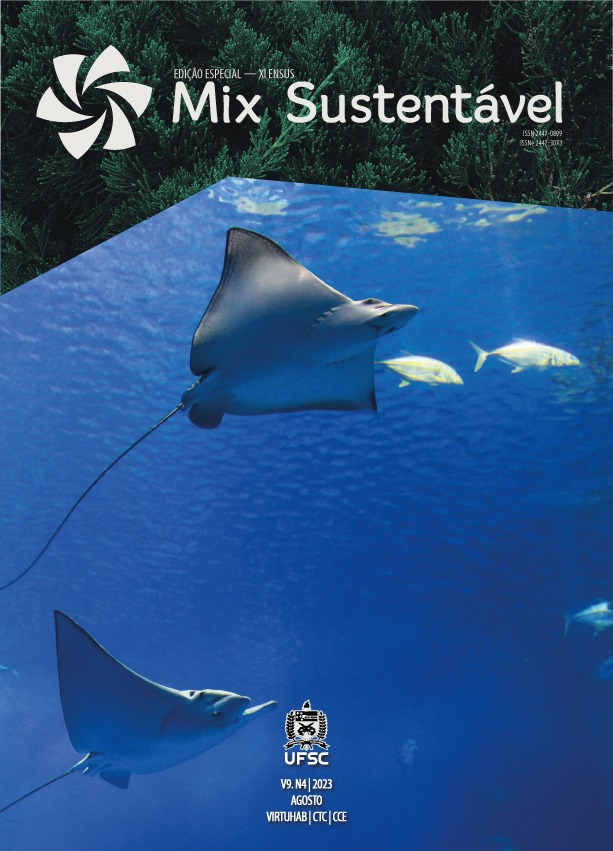VOLATILE ORGANIC COMPOUNDS IN SUSTAINABLE POLYMERIC MATERIALS FOR ARCHITECTURAL AND INTERIOR USE, CASE STUDY AT PONTIFICIA UNIVERSIDAD JAVERIANA, BOGOTÁ - COLOMBIA
COMPUESTOS ORGÁNICOS VOLÁTILES EN MATERIALES POLIMÉRICOS SOSTENIBLES DE USO ARQUITECTONICO E INTERIORES, CASO DE ESTUDIO PONTIFICIA UNVERSIDAD JAVERIANA, BOGOTÁ - COLOMBIA
DOI:
https://doi.org/10.29183/2447-3073.MIX2023.v9.n4.171-181Keywords:
Compostos orgânicos voláteis, polímeros, materiais de construção, sustentabilidade, imobiliáriaAbstract
Throughout the world, there is a growing interest in the proper use and consumption of sustainable raw materials that are based on the recycling and reuse of petroleum-derived polymers and other recycled materials, such as sheets from collaminates. These "sustainable alternatives" appear to be an attractive solution to environmental problems, however it is important to consider the potential environmental and public health impacts that may result from their use. Therefore, the objective of our research project is to analyze the VOC emissions of "sustainable" polymeric materials such boards and colaminateds. To this end, a prototype chamber for measuring organic compounds has been designed and manufactured by coupling a series of sensors for VOCs. The results have shown the presence of gases such as CO, NO2, NH3 and particulate matter, some of which are above the permitted limits of human exposure, concluding that the emissions of some VOCs may represent a potential risk for both environmental and human health. It is essential to continue researching to find sustainable alternatives that do not compromise the health and well-being of people and the environment.
References
CASTRO-HURTADO, I.; MANDAYO, G. G.; CASTAÑO, E. J. T. S. F. Conductometric formaldehyde gas sensors. A review: From conventional films to nanostructured materials. Thin Solid Films, v. 548, p. 665-676, 2013.
ZHU, L.; SHEN, D.; LUO, K. H. A critical review on VOCs adsorption by different porous materials: Species, mechanisms and modification methods. Journal of hazardous materials, v. 389, p. 122102, 2020.
DEMIREL, G. et al. Personal exposure of primary school children to BTEX, NO2 and ozone in Eskişehir, Turkey: Relationship with indoor/outdoor concentrations and risk assessment. Science of the total environment, v. 473, p. 537-548, 2014.
ADAMOVÁ, T.; HRADECKÝ, J.; PÁNEK, M. Volatile organic compounds (VOCs) from wood and wood-based panels: Methods for evaluation, potential health risks, and mitigation. Polymers, v. 12, n. 10, p. 2289, 2020.
CICOLELLA, A. Volatile Organic Compounds (VOC): definition, classification and properties. Revue des maladies respiratoires, v. 25, n. 2, p. 155-163, 2008.
ISO, I. 16000-5: Indoor Air—Part 5: Sampling Strategy for Volatile Organic Compounds (VOCs). ISO: Geneva, Switzerland, 2007.
GMINSKI, R. et al. Chemosensory irritations and pulmonary effects of acute exposure to emissions from oriented strand board. Human & experimental toxicology, v. 30, n. 9, p. 1204-1221, 2011.
KIM, S. et al. TVOC and formaldehyde emission behaviors from flooring materials bonded with environmental-friendly MF/PVAc hybrid resins. Indoor Air, v. 17, n. 5, p. 404, 2007.
BROWN, S. K. Occurrence of volatile organic compounds in indoor air. In: ORGANIC INDOOR AIR POLLUTANTS: OCCURRENCE—MEASUREMENT—EVALUATION. Springer, p. 170-184, 1999.
VAN DER WAL, J. F.; HOOGEVEEN, A. W.; WOUDA, P. The influence of temperature on the emission of volatile organic compounds from PVC flooring, carpet, and paint. Indoor air, v. 7, n. 3, p. 215-221, 1997.
KIRKESKOV, L. et al. Health evaluation of volatile organic compound (VOC) emission from exotic wood products. Indoor air, v. 19, n. 1, p. 45, 2009.
WIGLUSZ, R. et al. Volatile organic compounds emissions from particleboard veneered with decorative paper foil. Polimery, v. 47, n. 4, p. 283-289, 2002.
DU, Z. et al. Benzene, toluene and xylenes in newly renovated homes and associated health risk in Guangzhou, China. Building and Environment, v. 72, p. 75-81, 2014
Adamová, T., Hradecký, J., & Pánek, M. (2020). Volatile organic compounds (VOCs) from wood and wood-based panels: Methods for evaluation, potential health risks, and mitigation. Polymers, 12(10), 1–21. https://doi.org/10.3390/polym12102289
AUSÍN, V., ABELLA, V., DELGADO, V., & HORTIGÜELA, D. (2016). Aprendizaje basado en proyectos a través de las TIC. Una experiencia de innovación docente desde las aulas universitarias. Formacion Universitaria, 9(3), 31–38. https://doi.org/10.4067/S0718-50062016000300005
BALDASSARRE, B., KESKIN, D., DIEHL, J. C., BOCKEN, N., & CALABRETTA, G. (2020, November 10). Implementing sustainable design theory in business practice: A call to action. Journal of Cleaner Production, Vol. 273. https://doi.org/10.1016/j.jclepro.2020.123113
BELUCIO, M., RODRIGUES, C., ANTUNES, C. H., FREIRE, F., & DIAS, L. C. (2021). Eco-efficiency in early design decisions: A multimethodology approach. Journal of Cleaner Production, 283, 124630. https://doi.org/10.1016/j.jclepro.2020.124630
BOORSMA, N., BALKENENDE, R., BAKKER, C., TSUI, T., & PECK, D. (2021). Incorporating design for remanufacturing in the early design stage: a design management perspective. Journal of Remanufacturing, 11(1), 25–48. https://doi.org/10.1007/s13243-020-00090-y
Ramli, N. A., & Yunus, R. M. (2020). Awareness and attitudes towards sustainable development in higher education institutions in Malaysia. Journal of Cleaner Production, 266, 121994. https://doi.org/10.1016/j.jclepro.2020.121994
Romano, M., Giaccone, R., & Zanetti, M. C. (2020). Eco-design practices: A systematic review and bibliometric analysis. Journal of Cleaner Production, 275. https://doi.org/10.1016/j.jclepro.2020.123001
Scrucca, F., Fattore, G., & Parente, R. (2020). Circular economy and sustainability: A bibliometric analysis and future research directions. Journal of Cleaner Production, 263. https://doi.org/10.1016/j.jclepro.2020.121582
van der Voordt, T., & Knoepfel, P. (2018). Planning sustainable buildings: An update on recent progress. Journal of Cleaner Production, 172, 2339–2345. https://doi.org/10.1016/j.jclepro.2017.07.031
Zhang, R., Wang, H., Tan, Y., Zhang, M., Zhang, X., Wang, K., … Xiong, J. (2021). Using a machine learning approach to predict the emission characteristics of VOCs from furniture. Building and Environment, 196(February), 107786. Disponível em: https://doi.org/10.1016/j.buildenv.2021.107786. Acesso em: 19 mar. 2023.
Downloads
Published
How to Cite
Issue
Section
License
Copyright (c) 2023 Willmar Ricardo Rugeles Joya

This work is licensed under a Creative Commons Attribution 4.0 International License.
Creative Commons Copyright Notice
Attribution 4.0 International




